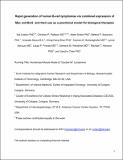| dc.contributor.author | Schweighofer, C. D. | |
| dc.contributor.author | Abruzzo, L. | |
| dc.contributor.author | Frenzel, Lukas P. | |
| dc.contributor.author | Wendtner, C. M. | |
| dc.contributor.author | Leskov, Ilya B. | |
| dc.contributor.author | Pallasch, Christian | |
| dc.contributor.author | Drake, Adam | |
| dc.contributor.author | Iliopoulou, Bettina P. | |
| dc.contributor.author | Souza, A. | |
| dc.contributor.author | Shen, C.-H. | |
| dc.contributor.author | Hemann, Michael | |
| dc.contributor.author | Chen, Jianzhu | |
| dc.date.accessioned | 2014-03-10T18:39:02Z | |
| dc.date.available | 2014-03-10T18:39:02Z | |
| dc.date.issued | 2012-04 | |
| dc.date.submitted | 2012-02 | |
| dc.identifier.issn | 0950-9232 | |
| dc.identifier.issn | 1476-5594 | |
| dc.identifier.uri | http://hdl.handle.net/1721.1/85587 | |
| dc.description.abstract | Although numerous mouse models of B-cell malignancy have been developed via the enforced expression of defined oncogenic lesions, the feasibility of generating lineage-defined human B-cell malignancies using mice reconstituted with modified human hematopoietic stem cells (HSCs) remains unclear. In fact, whether human cells can be transformed as readily as murine cells by simple oncogene combinations is a subject of considerable debate. Here, we describe the development of humanized mouse model of MYC/BCL2-driven ‘double-hit’ lymphoma. By engrafting human HSCs transduced with the oncogene combination into immunodeficient mice, we generate a fatal B malignancy with complete penetrance. This humanized-MYC/BCL2-model (hMB) accurately recapitulates the histopathological and clinical aspects of steroid-, chemotherapy- and rituximab-resistant human ‘double-hit’ lymphomas that involve the MYC and BCL2 loci. Notably, this model can serve as a platform for the evaluation of antibody-based therapeutics. As a proof of principle, we used this model to show that the anti-CD52 antibody alemtuzumab effectively eliminates lymphoma cells from the spleen, liver and peripheral blood, but not from the brain. The hMB humanized mouse model underscores the synergy of MYC and BCL2 in ‘double-hit’ lymphomas in human patients. Additionally, our findings highlight the utility of humanized mouse models in interrogating therapeutic approaches, particularly human-specific monoclonal antibodies. | en_US |
| dc.description.sponsorship | Kathy and Curt Marble Cancer Research Fund | en_US |
| dc.description.sponsorship | Singapore-MIT Alliance for Research and Technology | en_US |
| dc.description.sponsorship | National Institutes of Health (U.S.) (Grant R01-CA128803) | en_US |
| dc.description.sponsorship | Virginia and Daniel K. Ludwig Graduate Fellowship | en_US |
| dc.description.sponsorship | National Institute of General Medical Sciences (U.S.) (Medical Scientist Training Program Grant T32GM007753) | en_US |
| dc.description.sponsorship | MIT School of Science (Cancer Research Fellowship) | en_US |
| dc.language.iso | en_US | |
| dc.publisher | Nature Publishing Group | en_US |
| dc.relation.isversionof | http://dx.doi.org/10.1038/onc.2012.117 | en_US |
| dc.rights | Creative Commons Attribution-Noncommercial-Share Alike | en_US |
| dc.rights.uri | http://creativecommons.org/licenses/by-nc-sa/4.0/ | en_US |
| dc.source | Chen | en_US |
| dc.title | Rapid generation of human B-cell lymphomas via combined expression of Myc and Bcl2 and their use as a preclinical model for biological therapies | en_US |
| dc.type | Article | en_US |
| dc.identifier.citation | Leskov, I, C. P. Pallasch, A. Drake, B. P. Iliopoulou, A. Souza, C.-H. Shen, C. D. Schweighofer, et al. “Rapid Generation of Human B-Cell Lymphomas via Combined Expression of Myc and Bcl2 and Their Use as a Preclinical Model for Biological Therapies.” Oncogene 32, no. 8 (February 21, 2013): 1066–1072. | en_US |
| dc.contributor.department | Massachusetts Institute of Technology. Department of Biology | en_US |
| dc.contributor.department | Koch Institute for Integrative Cancer Research at MIT | en_US |
| dc.contributor.approver | Chen, Jianzhu | en_US |
| dc.contributor.mitauthor | Leskov, Ilya B. | en_US |
| dc.contributor.mitauthor | Pallasch, Christian | en_US |
| dc.contributor.mitauthor | Drake, Adam | en_US |
| dc.contributor.mitauthor | Iliopoulou, Bettina P. | en_US |
| dc.contributor.mitauthor | Souza, A. | en_US |
| dc.contributor.mitauthor | Shen, C.-H. | en_US |
| dc.contributor.mitauthor | Hemann, Michael | en_US |
| dc.contributor.mitauthor | Chen, Jianzhu | en_US |
| dc.relation.journal | Oncogene | en_US |
| dc.eprint.version | Author's final manuscript | en_US |
| dc.type.uri | http://purl.org/eprint/type/JournalArticle | en_US |
| eprint.status | http://purl.org/eprint/status/PeerReviewed | en_US |
| dspace.orderedauthors | Leskov, I; Pallasch, C. P.; Drake, A.; Iliopoulou, B. P.; Souza, A.; Shen, C.-H.; Schweighofer, C. D.; Abruzzo, L.; Frenzel, L. P.; Wendtner, C. M.; Hemann, M. T.; Chen, J. | en_US |
| dc.identifier.orcid | https://orcid.org/0000-0002-5687-6154 | |
| dspace.mitauthor.error | true | |
| mit.license | OPEN_ACCESS_POLICY | en_US |
| mit.metadata.status | Complete | |

